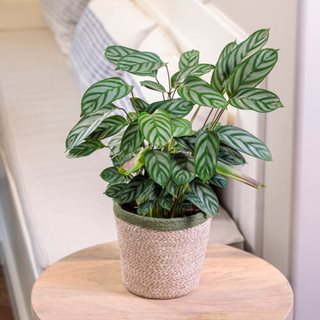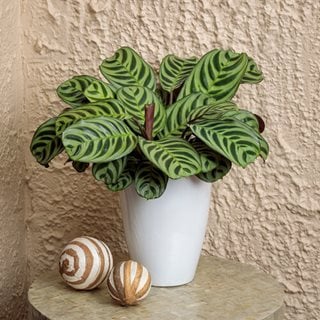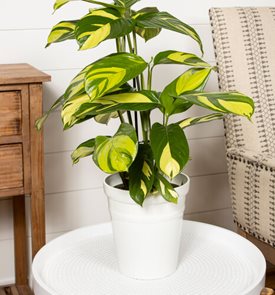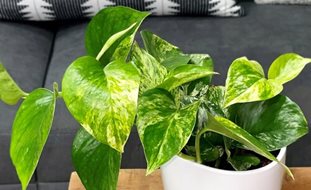How to Grow Never Never Plant (Ctenanthe)
Get care and maintenance tips for this showy foliage plant, and take a look at some of the newest varieties.
Sweet Dreams® Exotica. Photo by: Proven Winners
If you’ve never heard of a never never plant (Ctenanthe), you’re not alone. Although it looks similar to the popular prayer plant and belongs to the same family, this beautifully variegated houseplant has only recently started to gain a following, thanks to the introduction of new cultivars that greatly expand the range of foliage colors and patterns. Each plant is irresistibly unique, with some sporting intricate fishbone markings while others are adorned by bold stripes and splotches.
Because never never plants are native to tropical rainforests, they can be a bit fussy about their growing conditions and require consistent watering and high humidity to thrive. But if you can meet its basic needs, this head-turning houseplant makes a wonderful addition to any indoor plant collection.
On this page: Basics | Growing Tips | Care | Varieties | FAQs
On this page:
- CTENANTHE PLANT BASICS
- GROWING CTENANTHE PLANTS
- CTENANTHE PLANT CARE
- CTENANTHE PLANT VARIETIES
- FREQUENTLY ASKED QUESTIONS
BASICS
Botanical name:
Ctenanthe spp. (prounounced ten-AN-thee)
Common names:
Never never plant, fishbone prayer plant, bamburanta
Origin:
Native to tropical rainforests of Central and South America
Care level:
Moderate
Light:
Medium to bright, indirect light
Height:
1 to 4 feet, depending on the variety
Foliage:
Features elliptical or oval-shaped leaves with distinctive markings and variegation. Leaf colors range from silvery gray to dark green, with some having purple or burgundy undersides.
Flowers:
May produce small, insignificant white flowers in summer, but this is a rare occurrence when plants are grown indoors.
Fun fact:
Like many plants in the prayer plant family (Marantaceae), Ctenanthe folds up its leaves at night, giving them the appearance of praying hands. When the sun returns in the morning, the leaves unfold again to a flat position. This circadian movement, called nyctinasty, occurs in response to changes in light intensity.
GROWING CTENANTHE PLANTS
Where to grow:
Never never plants perform best in medium to bright indirect light, such as near a north- or east-facing window. Avoid placing them next to a window that gets direct sunlight, unless it is early morning or late afternoon sun. Exposure to direct midday sun can scorch the leaves.
Temperature and humidity:
Like many tropical houseplants, never never plant prefers moderate to high levels of humidity and comfortable room temperatures of 60° to 85° F. To increase humidity, use a humidifier, mist the leaves regularly, or set your plant on a shallow tray filled with pebbles and water. See more houseplants that thrive in humidity.
Also, avoid placing your never never plant near drafty windows or heating vents. If the leaf tips start turning brown and crispy, it is likely that your plant is suffering from a lack of humidity.
Soil type:
Use a high-quality, all-purpose potting mix that drains well. To help promote drainage and improve airflow, consider adding some perlite or orchid bark to the mix.
Pot requirements:
Plant in a pot slightly larger in diameter than the rootball and with adequate drainage holes to help prevent root rot.

Sweet Dreams® Grey Star. Photo by: Proven Winners
CTENANTHE PLANT CARE
Watering:
Because Ctenanthe is a rainforest plant, it loves consistently moist but not waterlogged soil. For the best results, water thoroughly when the top 1 to 2 inches of soil feels dry to the touch, allowing the excess water to drain from the bottom of the pot. Do not allow your plant to sit in standing water, which can result in chlorosis (yellowing of the leaves) and root rot.
TIP: Never never plants are sensitive to impurities and salts in tap water, which can result in leaf spotting. It’s best to water using distilled or filtered water or tap water that has been left out overnight so the minerals can settle. The water should also be at room temperature to avoid shock to the plant’s root system.
Fertilizing:
Apply a balanced water-soluble fertilizer diluted to half strength once a month during spring through early fall, when your plant is actively growing. Hold off on fertilizing during the late fall and winter months, when plant growth slows.
Pruning:
Because of its bushy growth habit, Ctenanthe rarely requires pruning to maintain its shape. However, you should trim off any dead or browning foliage back to the base of the plant to encourage healthy, new growth.
Leaf care:
To keep the beautiful foliage of your never never plant dust-free, occasionally wipe the leaves with a damp cloth or sponge. Cleaning the foliage regularly also gives you a good opportunity to check for insect pests that might be hiding on the undersides of the leaves.
Repotting:
Ctenanthe grows fairly slowly, so it can generally stay in the same pot for 2 to 3 years before it’s ready for a new home. If your plant begins showing signs of becoming rootbound, move it to a pot about 2 inches larger in diameter than the current one and fill it with fresh potting mix. The best time to repot is in spring or early summer, when the roots are actively growing and will benefit from the extra space.
Pests and diseases:
Be on the watch for common houseplant pests, particularly spider mites, aphids, and mealybugs. If you notice any signs of an infestation, isolate your plant and provide treatment immediately. Learn more about identifying and treating the most common houseplant pests.
CTENANTHE PLANT VARIETIES
FREQUENTLY ASKED QUESTIONS

Sweet Dreams® Burle-Marxii. Photo by: Proven Winners
Is Ctenanthe a good indoor plant?
In its native habitat, never never plant resides in the understory of tropical forests and therefore adjusts well to the lower light levels and warmth of an indoor environment. This makes it an excellent houseplant, as long as you cater to its needs for frequent watering and plenty of humidity.
During the summer, you can also grow never never plant outdoors in a shady location. However, it is very sensitive to frost exposure and must be moved indoors in the fall in all but the warmest climates.
Are never never plants toxic?
Ctenanthes are non-toxic and safe for people and pets, but can cause stomach upset if ingested in large quantities.
Is Ctenanthe a prayer plant?
Ctenanthe is related to the prayer plant (Maranta) and belongs to the same family, along with Calathea and Stromanthe. All these plants are known for their colorful foliage and share similar care requirements. However, there are some differences in leaf shapes, leaf patterns, and growth habits.
Does Ctenanthe need sun?
Yes, but you should avoid exposing your plant to direct sunlight. Bright or filtered light is ideal for Ctenanthe and will result in the most vibrant foliage color. At lower light levels the leaves may start losing their variegation and growth can become leggy.
Does never never plant like to be rootbound?
If you want your never never plant to remain healthy and grow to its full potential, you should repot it before it becomes rootbound. If you notice that the soil doesn’t hold moisture for long and the roots begin to poke out of the pot’s drainage holes, those are signs that it’s time for repotting.
Why are the leaves of my ctenanthe plant curling?
Leaves that fold up at night are normal for a never never plant, but if they remain curled during the day, that is often a sign of distress. Make sure the room temperature is between 60° to 85° F and increase the humidity if necessary. Your Ctenanthe may also curl up its leaves if it isn’t getting enough water.









